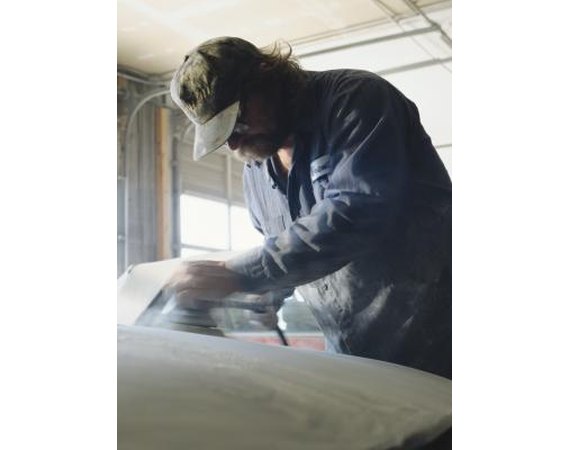
Most of the time and work put into painting a car involves preparing the metal body panels for the paint job. A good paint job requires a smooth, rust-free car body for a starting point. Automotive bodywork and painting is more of an artistic endeavor than doing mechanical repairs. It requires a developed eye and a dedication to perfection. A finished car with a shiny, showroom-quality paint job is well worth the effort and time.
Instructions
- 1
Take off all the old paint with an electric orbital, rotary sander. Start with rough-grit sandpaper to take off the lion's share of the paint. Switch to medium-, then fine-grit sandpaper to remove the remaining paint. Inspect the entire body for rust. Hand-sand the rust off with a sanding block. Use a flexible block for curved body parts and hard-to-access areas. Keep sanding until every speck of rust is gone. Use a media blaster with sand or plastic particles to save time stripping the paint.
2Use metal snips or an acetylene torch to cut out badly rusted areas. Use a grinder or a knottted wire brush attachment to remove all rust from the edges of the damaged area. Cut and weld in new sheet metal. Use stitch welding of widely spaced short segments to prevent body panel rippling from the heat cased by continuous welding. Grind down the welds and sand until smooth.
3Visually inspect and feel the body for nicks, dings, dents, and convex or concave spots. Rent or buy a full set of hammers and body dollies. Straighten out the body panels with the tools. Fill in depressions and scratches with body filler. Use a thin, flexible putty knife to apply. Sand the filler smooth after it's dry. Block-sand all blemishes and rough spots. Run your hands over the body to feel for any imperfections.
4Wipe the car down with clean tack cloth to remove all dust and foreign particles. Cover all non-painted areas and parts with automotive masking tape and paper. Paint the car indoors in a ventilated space. Use a paint gun to evenly apply a coat of red oxide primer over the car body. Use a self-etching epoxy primer if the car is susceptible to rust. Block-sand the primer after drying.
5Spray on a color coat of urethane paint. Paint with even, smooth strokes. Take care to avoid puddling, drips and runs. Keep debris, dust, bugs and hair out of the paint. Apply several more coats and lightly sand where needed between coats. Spray on the top clear coat. Use two or three coats. Color-sand to remove patches of orange-peel texture. Polish for a lustrous shine.
0 comments:
Post a Comment